The Confucius Temple in Nanjing was a place to worship and consecrate
Confucius, a great philosopher and educator of ancient China. It is also known as Fuzimiao in Chinese. Originally, the temple was constructed in the year of 1034 in the Song Dynasty (420-589). It suffered repeated damage and has been rebuilt on several occasions since that time. 1937 was the most destruction when it was burnt to ruin by Japanese aggressors. In 1984 the temple was rebuilt under the support of the local government. During the long process, the original building expanded to be a complex building in the architectural style of the Ming (1368-1644) and Qing (1644-1911) dynasties, including the Nanjing Confucius Temple itself,
China Imperial Examination Museum and Xue Gong (the Imperial Academy). The complex is still called the Confucius Temple out of habit by locals and visitors.
In front of the Nanjing Confucius Temple, the
Qin Huai River is flowing. On the south bank of the river, there is the longest screen wall in China which is 110-meter-long (about 120 yards) and piled with bricks. The Dacheng Hall is recommended on your trip. It is 16.22 meters high (about 53 feet) and 28.1 meters (about 30 yards) wide featuring a 1.5-meter-high (about 5 feet) pedestal. There are two worthwhile attractions found in the inner hall. One is the largest figure of Confucius in China. The other one is the beautiful collection of 38 vivid panels which are made by various jade, gold and silver, detailing the life of Confucius. Out of the hall, you will see the bronze statue of Confucius as well as the white marble statues of his eight disciples.
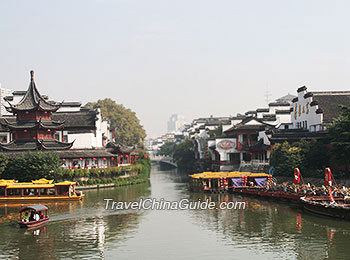 | | Qin Huai River | | 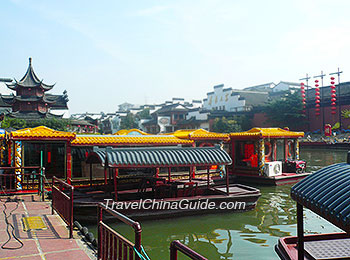 | | Qin Huai River | |
A fantastic insight into how ancient Chinese governments choose officials can be gained from visiting the Jiangnan Gongyuan. It is a sight not to be missed. The development of Gongyuan began in the Southern Song Dynasty, expanding into the Ming and Qing Dynasties, until in the reign of Emperor Guangxu in the Qing Dynasty. It developed to be the biggest exanimation school in China. The main building of Gongyuan is the three-storied Mingyuan Tower which is surrounded by 20,644 examination cells, called 'haoshe' in Chinese. Now, a specialized museum on the imperial civil examination system is built here. Visitors also have the opportunity to take simulated exams and experience the joys and sorrows of the candidates.
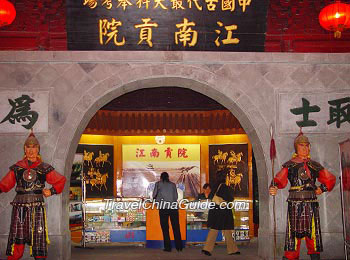 | | China Imperial Examination Museum | | 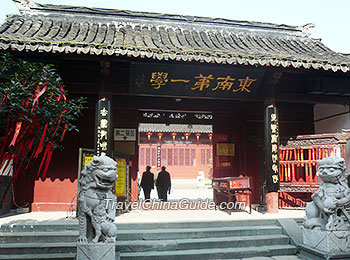 | | First School in Southeast China | |
The area around Nanjing Confucius Temple consists of a series of tourist shops, snack bars, restaurants and tea cafes. They all appear to be in the architectural style of the Ming and Qing style. A variety of snacks encompassing eight of the most famous flavours are available for purchase at here. Everyone's individual tastes are well catered for. They are necessary parts of food culture in Nanjing.
Not far from the pedestrian street, there is
Bailuzhou Park. Unlike the bustling area, it’s quiet and peaceful. If you want to seek quiet, you can go there to feel another version of Nanjing.
How to get to Nanjing Confucius Temple
1. Take
Metro line 3 to Fuzimiao (Nanjing Confucius Temple) or
line 1 to Sanshanjie.
2. Take bus 4, 7, 30, 31, 40, 44, 49, 202, or 304 to Jiankang Lu, Fuzimiao.
3. Take bus 1 or G5 to Taipingnan Lu, Fuzimiao.
Nanjing Bus / Metro Search | Dacheng Hall | Jiangnan Examination School (Jiangnan Gongyuan) |
| Entrance Fee | CNY30;
CNY15 for children between 1.3 and 1.5m (4.3 - 4.9 feet). | CNY50 |
| Opening Hours | 9:00 - 21:30 | 9:00 - 22:00 |
- Last updated on Feb. 25, 2024 -
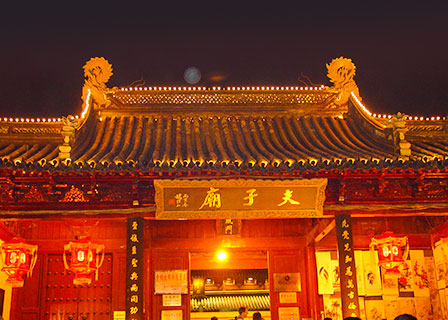
![]() Further Reading:
Further Reading:![]() Further Reading:
Further Reading:


